Characteristics of Battery SOC According to Drive Output and Battery Capacity of Parallel Hybrid Electric Vehicle
Abstract
:1. Introduction
Related Previous Research
2. Experimental Apparatus and Setup
3. Numerical Modeling and Verification
4. Results and Discussion
4.1. Experiment Results of Power Distribution with Two Driving Modes for TMED-Type Hybrid Vehicle
4.2. Numerical Analysis of Characteristic of SOC and Current Balance with IM240 Mode
5. Conclusions
- At low-speeds, there is negligible engine operation, and the motor operates primarily. The difference in SOC drop was not significantly caused by the energy recovered by the regenerative braking of the drive motor and the advantage of the motor, which is more efficient than the engine.
- For efficient battery use, SOC is charged to near 50%. Therefore, if the battery capacity is small, it is charged to 50% quickly, and the extra electricity cannot be charged. For this reason, the difference in SOC drop occurs because the change in torque is more significant than the change in battery capacity.
- When the battery capacity is reduced by 20%, the SOC between the IM240 and FTP-75 modes differs by 3% only. By using a variety of strategies (e.g., downsizing, engine operation strategy, SOC increase) to compensate for the SOC drop, it will be possible to operate HEVs at lower battery capacities.
Author Contributions
Funding
Conflicts of Interest
References
- Ministry of Environment. Available online: https://www.me.go.kr/mamo/web/index.do?menuId=590 (accessed on 18 July 2019).
- Ministry of Environment. 2014; Volume 4. Available online: http://www.me.go.kr/home/file/readDownloadFile.do?fileId=110646&fileSeq=1&openYn=Y (accessed on 18 July 2019).
- Won, H.W. The emissions legislation and developments of road transport technology in Europe. J. Korean Soc. Automot. Eng. 2017, 39, 16–20. [Google Scholar]
- Jang, B.H. Available online: www.itfind.or.kr/admin/getFile.htm?identifier=02-004-180503-000008 (accessed on 18 July 2019).
- Wall, M. Automotive Industry Outlook: Managing Volatility and Leveraging Opportunities in a Dynamic Market Environment; IHS Markit: London, UK, 2019. [Google Scholar]
- Ministry of Trade, Industry and Energy. Act on Promotion of Development and Distribution of Environment-Friendly Motor Vehicles; Ministry of Trade, Industry and Energy: Sejong, Korea, 2019.
- Ministry of Environment. 2018. Available online: http://www.me.go.kr/home/web/board/read.do;jsessionid=hy9zwcQQzELS5+kNFYM+T1wd.mehome2?pagerOffset=0&maxPageItems=10&maxIndexPages=10&searchKey=&searchValue=&menuId=10181&orgCd=&boardId=922990&boardMasterId=54&boardCategoryId=&decorator= (accessed on 18 July 2019).
- Shiau, C.; Samaras, C.; Hauffe, R.; Michalek, J. Impact of battery weight and charging patterns on the economic and environmental benefits of plug-in hybrid vehicles. Energy Policy 2009, 37, 2653–2663. [Google Scholar] [CrossRef]
- Liao, Y.; Allen, M.; Quail, J. Traction motor sizing for optimal fuel economy in propulsion hybridization. Open Mech. Eng. J. 2012, 6, 1–11. [Google Scholar] [CrossRef] [Green Version]
- Hofer, J.; Wilhelm, E.; Schenler, W. Optimal light weighting in battery electric vehicles. World Electr. Veh. J. 2012, 5, 751–762. [Google Scholar] [CrossRef] [Green Version]
- Cheng, M.; Feng, L.; Chen, B. Nonlinear Model Predictive Control of a Power-Split Hybrid Electric Vehicle with Electrochemical Battery Model; SAE Technical Paper 2017-01-1252; SAE International: Warrendale, PA, USA, 2017. [Google Scholar]
- Zhou, B.; Burl, J.; Rezaei, A. Hybrid Electric Vehicle Battery Aging Estimation and Economic Analysis Based on Equivalent Consumption Minimization Strategy; SAE Technical Paper 2017-01-1251; SAE International: Warrendale, PA, USA, 2017. [Google Scholar]
- Pilley, S.; Morkos, B.; Alfalahi, M. Integration and Modularity Analysis for Improving Hybrid Vehicles Battery Pack Assembly; SAE Technical Paper 2018-01-0438; SAE International: Warrendale, PA, USA, 2018. [Google Scholar]
- Uddin, A.; Ku, J. Design and Simulation of Lithium-Ion Battery Thermal Management System for Mild Hybrid Vehicle Application; SAE Technical Paper 2015-01-1230; SAE International: Warrendale, PA, USA, 2015. [Google Scholar]
- Zhang, X.; Filipi, Z. Computationally Efficient Li-Ion Battery Aging Model for Hybrid Electric Vehicle Supervisory Control Optimization; SAE Technical Paper 2017-01-0274; SAE International: Warrendale, PA, USA, 2017. [Google Scholar]
- Xu, X.; Wei, X.; Gao, H.; Zhu, J.; Yang, J.; Liu, Y. Research on Charging Strategy of Lithium-Ion Battery; SAE Technical Paper 2015-01-1192; SAE International: Warrendale, PA, USA, 2015. [Google Scholar]
- Feng, L.; Cheng, M.; Chen, B. Predictive Control of a Power-Split HEV with Fuel Consumption and SOC Estimation; SAE Technical Paper 2015-01-1161; SAE International: Warrendale, PA, USA, 2015. [Google Scholar]
- Zhou, B.; Burl, J.; Rezaei, A. Effect of State of Charge Constraints on Fuel Economy and Battery Aging when Using the Equivalent Consumption Minimization Strategy; SAE Technical Paper 2018-01-1002; SAE International: Warrendale, PA, USA, 2018. [Google Scholar]
- Khan, K.; Zhou, B.; Rezaei, A. Real Time Application of Battery State of Charge and State of Health Estimation; SAE Technical Paper 2017-01-1199; SAE International: Warrendale, PA, USA, 2017. [Google Scholar]
- Sriniwas, A.; Katyamandali, H.; Jarubula, P.; Nandagopalan, C.; Prabaharan, P. Experimental Analysis of Lead Acid Batteries for Estimating State of Charge and State of Health; SAE Technical Paper 2013-01-2742; SAE International: Warrendale, PA, USA, 2013. [Google Scholar]
- Sharma, D.; Reghunath, S.; Athreya, A. Dynamic Reserve Energy Storage for Hybrid Vehicle Fuel Economy Improvement; SAE Technical Paper 2015-26-0117; SAE International: Warrendale, PA, USA, 2015. [Google Scholar]
- Minarcin, M.; Rask, E. Considerations in estimating battery energy for hybrid and electric vehicles. SAE Int. J. Alt. Powertrains 2012, 1, 144–159. [Google Scholar] [CrossRef]
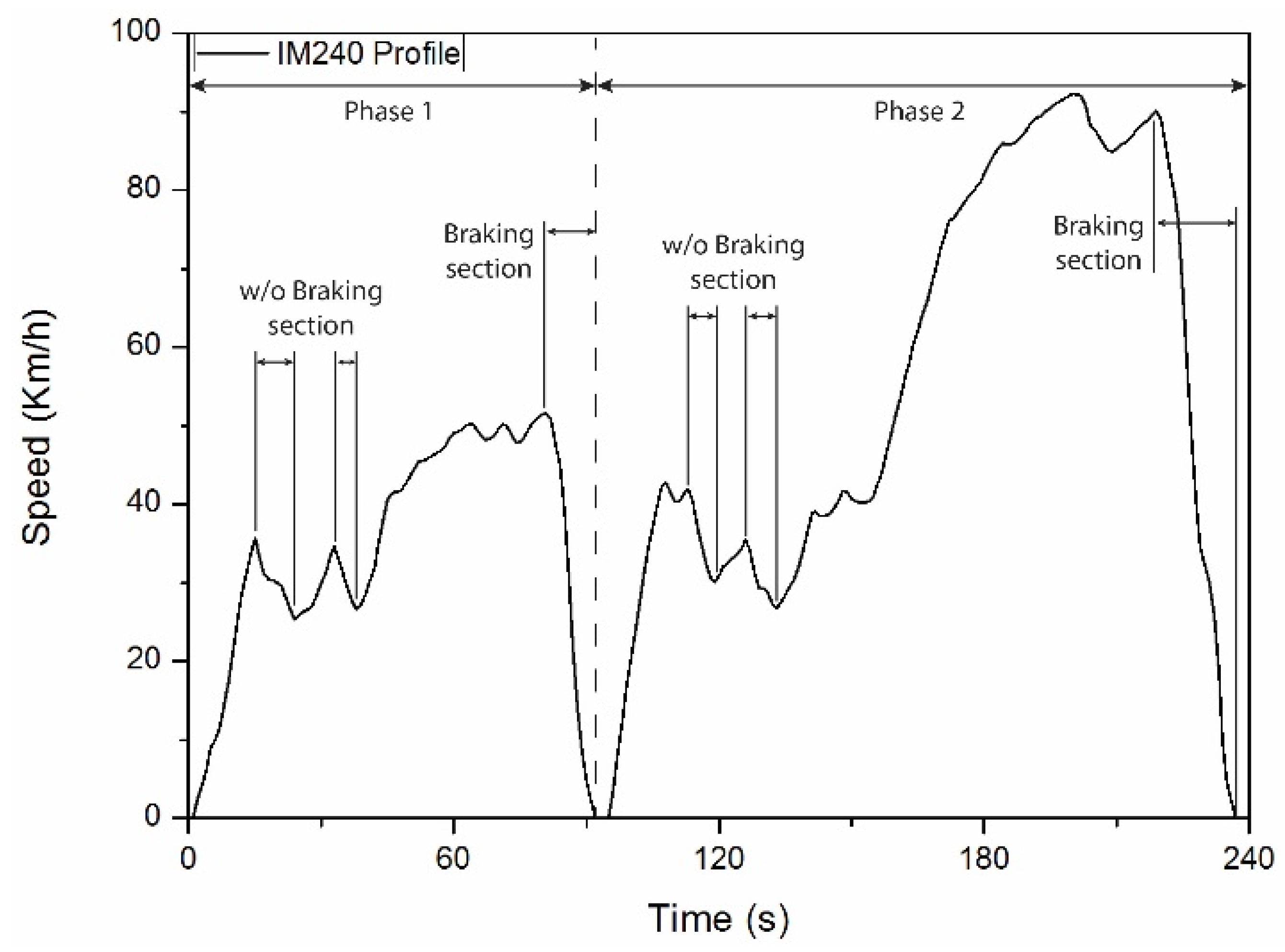



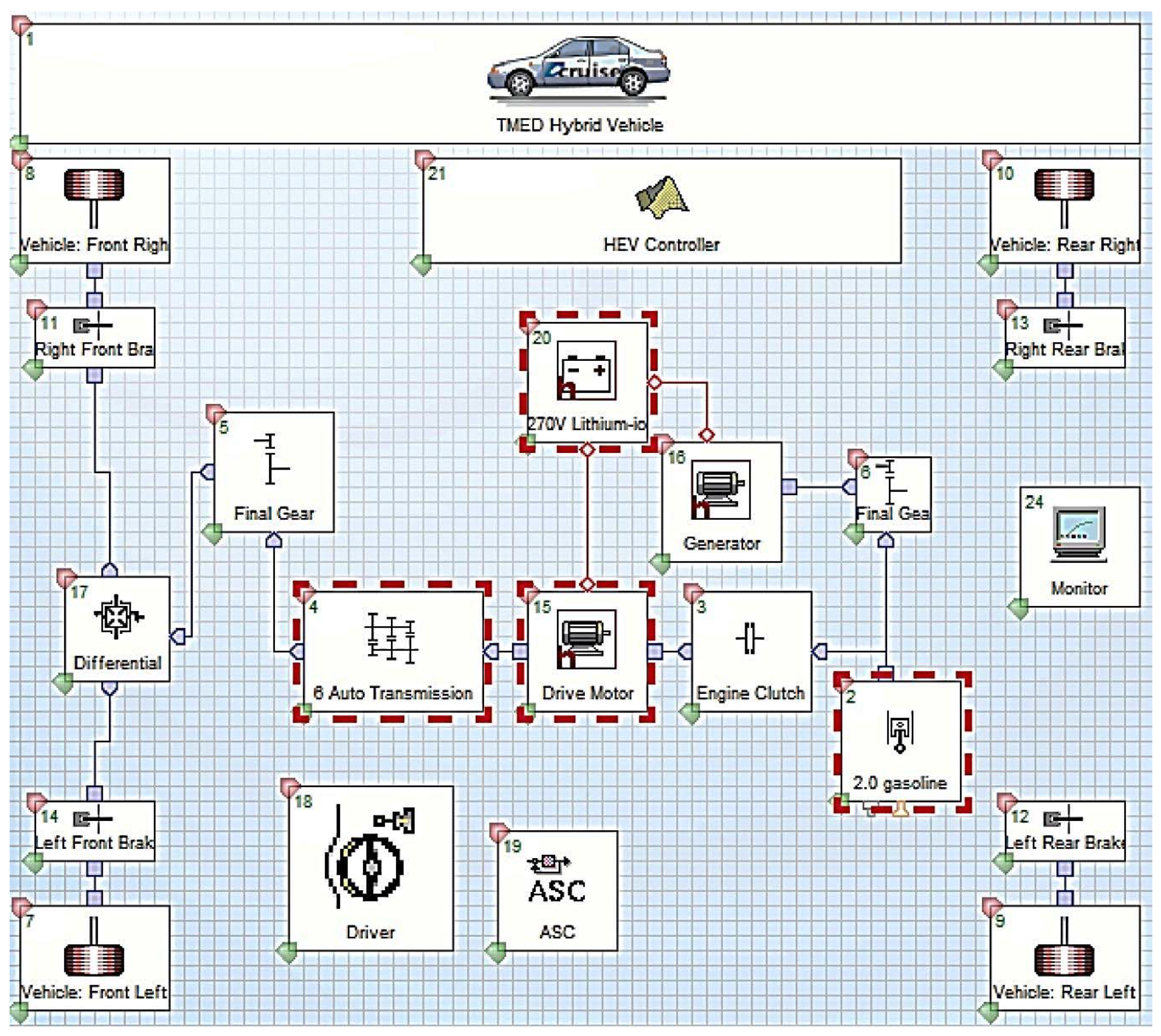
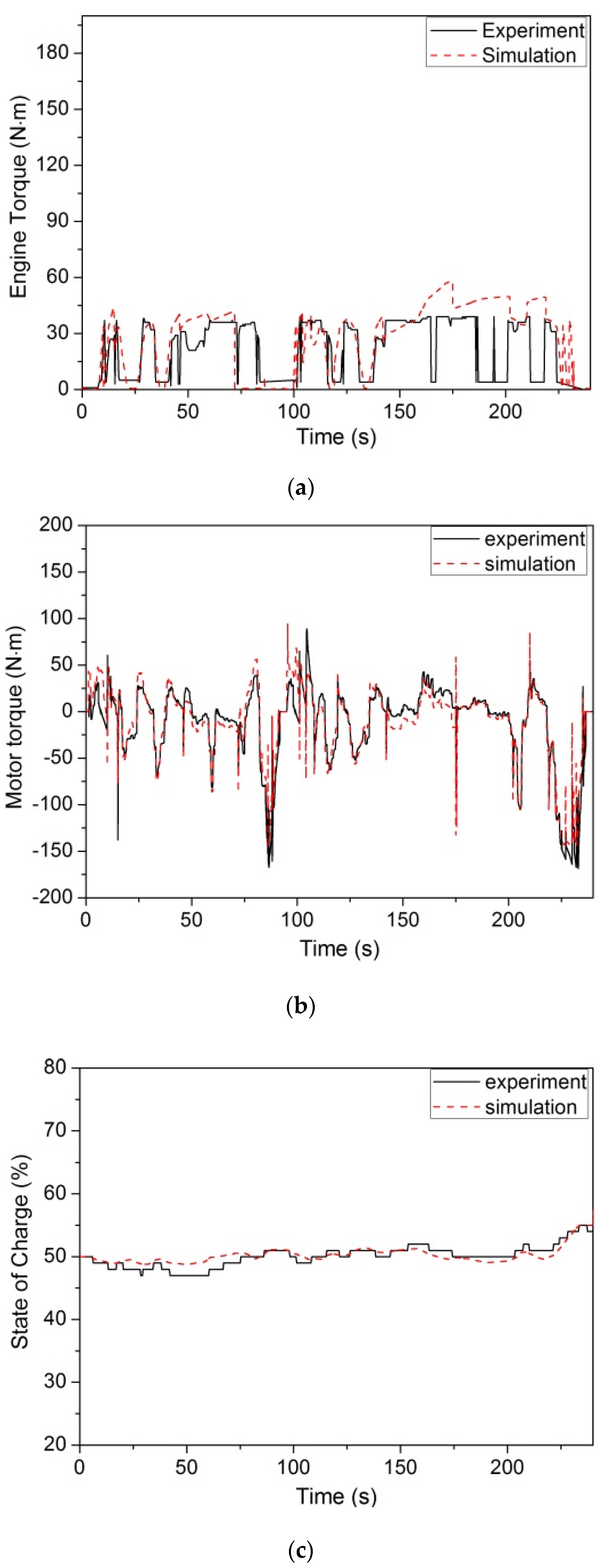
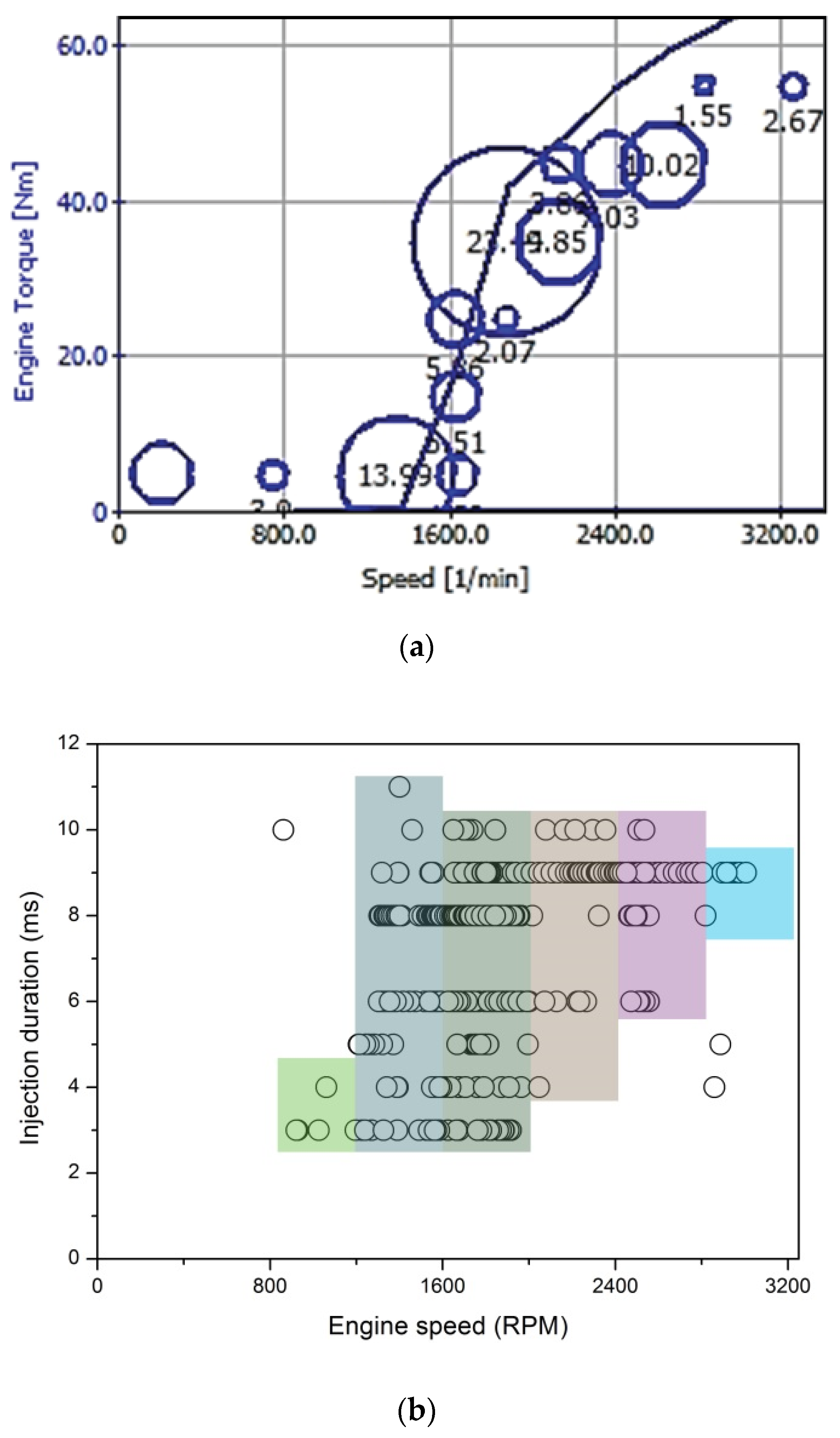


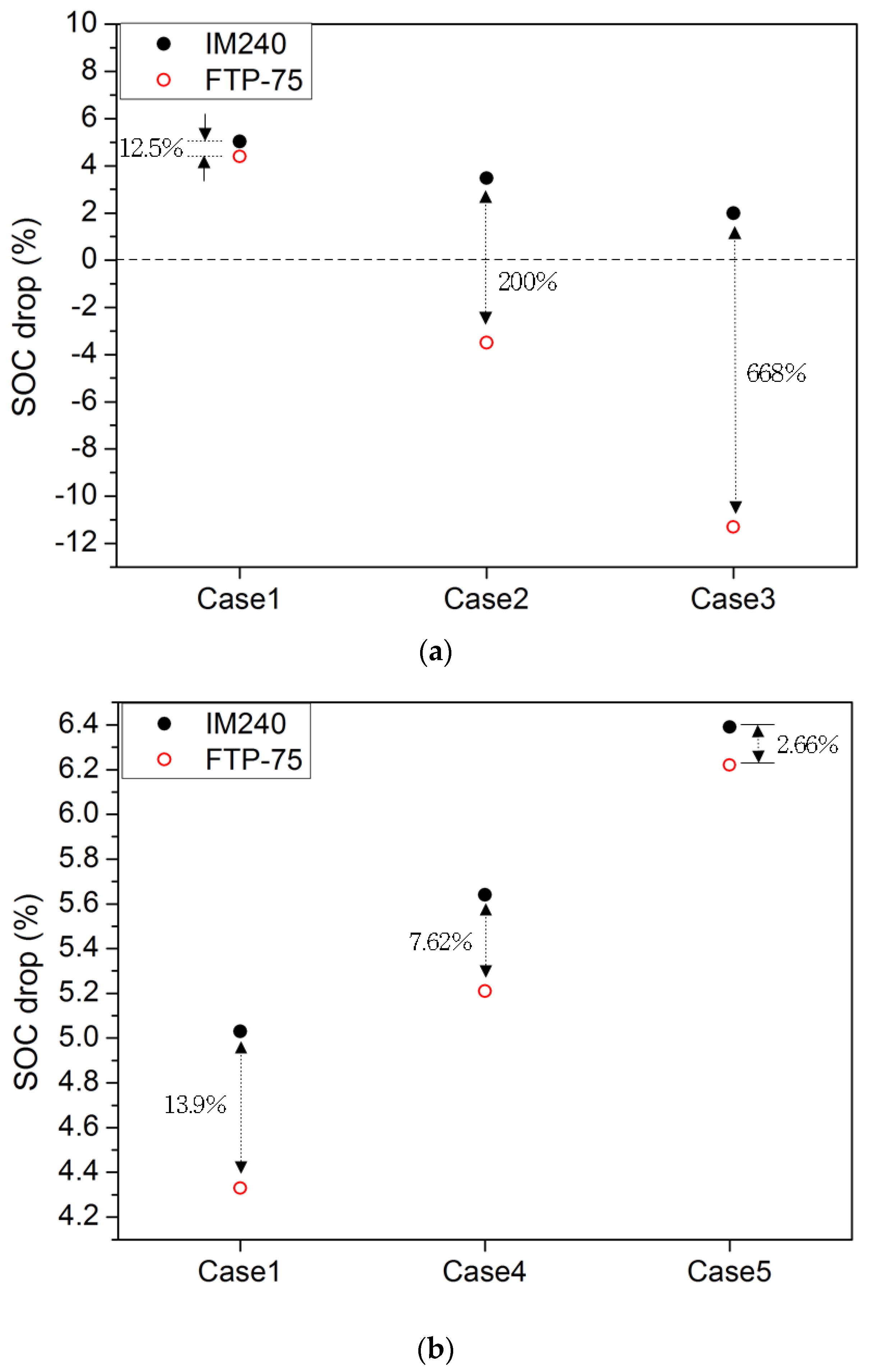
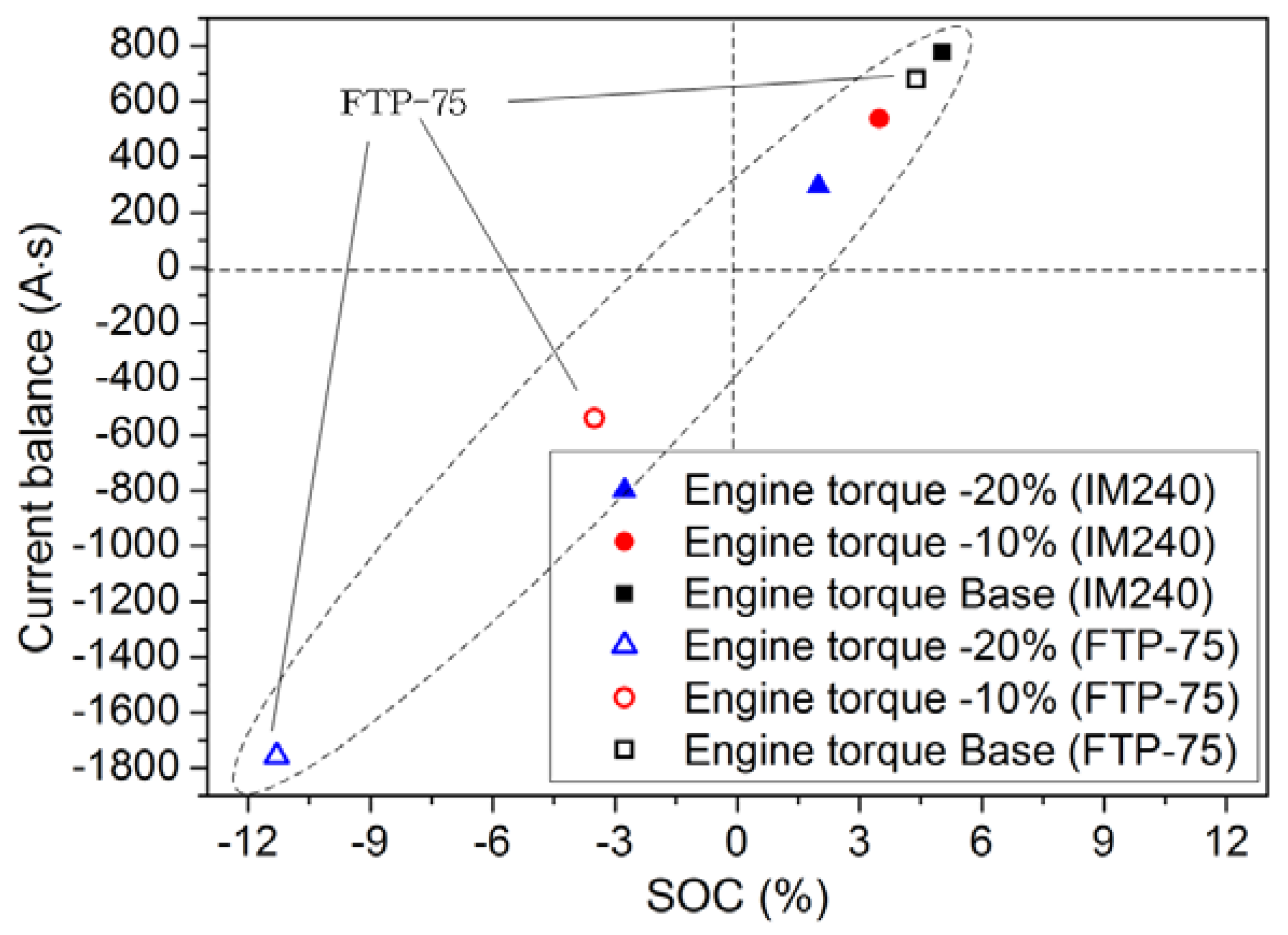

| Item | Unit | Specification |
|---|---|---|
| Engine | - | 2.0 L Atkinson cycle Double overhead cam |
| Max. power | PS | 150 |
| Max. torque | kg·m | 18.3 |
| Motor | - | 30 kW (41 PS)/20.9 kg·m |
| HSG | kW | 8.5 |
| Battery | - | Lithium polymer 5.3 A·h × 270 V = 1.431 kW·h 8 cells × 9 modules (1 cell: 3.75 V) Maximum charge/discharge power: 34 kW, −26 kW Operating voltage range: 200∼310 V Thermo sensor: Thermistor type |
| Element | Name | Major Variable |
|---|---|---|
 | Vehicle | 1. Curb weight 2. Gross weight |
 | HEV controller | 1. Controller of hybrid system |
 | Lithium-ion battery | 1. Maximum charge 2. Initial charge 3. Nominal, maximum and minimum voltage 4. Number of battery cells 5. Idle voltage |
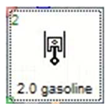 | Gasoline engine | 1. Torque diagram 2. Intake method setting (Charger) 3. Idling speed 4. Maximum speed 5. Engine displacement volume |
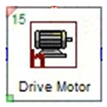 | Electric motor | 1. Nominal voltage 2. Maximum speed 3. Maximum charge/discharge current 4. Torque diagram |
 | Transmission | 1. Gear position 2. Transmission ratios |
| Component Requiring Input | Input Information | Component Delivering | Output Information |
|---|---|---|---|
| Cockpit driver | Gear indicator | Transmission | Current gear |
| Speed | TMED Hybrid Vehicle | Velocity | |
| Drive motor | Load signal | HEV controller | Electric motor load signal |
| Switch | HEV controller | Electric motor switch | |
| Engine | Load signal | HEV controller | Engine load signal |
| Start switch | HEV controller | Engine start switch | |
| Transmission | Desired gear | Cockpit driver | Desired gear from profile |
| HEV controller | Load signal | Cockpit driver | Load signal |
| Battery status of charge | Lithium-ion battery | Net voltage | |
| Engine torque | Engine | Current brake torque | |
| Battery current | Lithium-ion battery | Current | |
| Battery voltage | Lithium-ion battery | Battery charge |
| Engine Torque | |||
|---|---|---|---|
| Battery capacity (Base) | Rated torque (Base value) | 10% less than Base value | 20% less than Base value |
| Case 1 | Case 2 | Case 3 | |
| Battery Capacity | |||
|---|---|---|---|
| Engine torque (Base) | Rated capacity (Base value) | 10% less than Base value | 20% less than Base value |
| Case 1 | Case 4 | Case 5 | |
© 2020 by the authors. Licensee MDPI, Basel, Switzerland. This article is an open access article distributed under the terms and conditions of the Creative Commons Attribution (CC BY) license (http://creativecommons.org/licenses/by/4.0/).
Share and Cite
Cho, I.; Lee, J. Characteristics of Battery SOC According to Drive Output and Battery Capacity of Parallel Hybrid Electric Vehicle. Appl. Sci. 2020, 10, 2833. https://doi.org/10.3390/app10082833
Cho I, Lee J. Characteristics of Battery SOC According to Drive Output and Battery Capacity of Parallel Hybrid Electric Vehicle. Applied Sciences. 2020; 10(8):2833. https://doi.org/10.3390/app10082833
Chicago/Turabian StyleCho, Insu, and Jinwook Lee. 2020. "Characteristics of Battery SOC According to Drive Output and Battery Capacity of Parallel Hybrid Electric Vehicle" Applied Sciences 10, no. 8: 2833. https://doi.org/10.3390/app10082833





